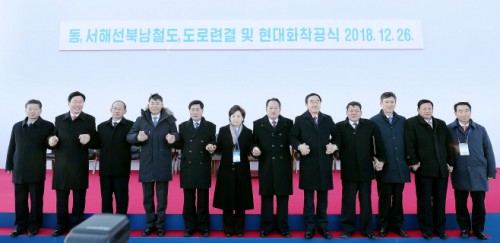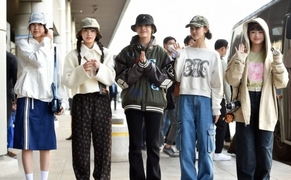 |
| South Korea’s Transport Minister Kim Hyun-mee (6-L), Ri Son-gwon (6-R), the chairman of North Korea’s state agency in charge of inter-Korean ties, South Korean unification minister Cho Myoung-gyon (5-R) and other officials attend the groundbreaking ceremony for the connection and modernization of South-North railways and roads on the east and west coast at the North Korean border town Panmun Station in Kaesong, North Korea, December 26./ Source: Joint Press Corps |
By AsiaToday reporters Lee Seok-jong & Heo Go-woon
North and South Korea held a groundbreaking ceremony Wednesday for the connection and modernization of South-North railways and roads on the east and west coast at the North Korean border town Panmun station in Kaesong, North Korea.
The historic groundbreaking ceremony is meaningful in that it reconnects severed inter-Korean railways that had been suspended for a decade. The leaders of two Koreas fulfilled their promise of holding a groundbreaking ceremony within the year, which was agreed during a September summit in Pyongyang. It also has a declarative meaning to signal the start of the East Asian Railway Community proposed by South Korean President Moon Jae-in.
Many representatives from organizations related to the East Asian Railway Community Initiative attended the event to give international support, including Chinese ambassador to South Korea Qiu Guohong, Hexiang Yan, deputy assistant at the Chinese Ministry of Railways, Russian Deputy Minister of Transport Vladimir Tokarev, Mongolian Minister of Road and Transport Development Yangug Sodbaatar, and Armida Alisjahbana, executive secretary of the United Nations Economic and Social Commission for Asia and the Pacific (UNESCAP).
“We know that connecting railways and roads is more than just a physical linking. Through the connected rails and roads, people will come and go, promoting exchanges and cooperation in culture, sports, tourism, forestry, health and various other areas,” South Korean Transport Minister Kim Hyun-mee said.
“The artery linking the South and the North will become the main blood vessel for East Asian co-prosperity and expand our economic horizon to the continent,” Kim said. “If the South and the North work together, they can leap higher globally.”
She said the connection would facilitate exchanges across the border and enhance the competitiveness in the world market. “The economic benefits would be shared by the two Koreas,” she added.
The transport minister said that Northeast Asia could take the initiative in economic cooperation and co-prosperity through the East Asian Railroad Community. “As Northeast Asia’s logistics hub, the Korean Peninsula will certainly attract more attention from companies around the world.”
North Korean Vice Railway Minister Kim Yun-hyok called the ceremony a meaningful event that demonstrates to the world the two Koreas’ strong power and willingness to reunify. “It is a historic occasion that shows the momentum for co-prosperity in Northeast Asia and the Eurasian region, and even co-prosperity for the entire world as well,” he said.
The groundbreaking ceremony featured events in which officials of the two Koreas signed a sleeper, connected railroad tracks and unveiled a road sign.
Five separated family members born in the North, including Kim Kum-ok, as well as Shin Jang-chul, who drove the last freight train between the Koreas, attended the event.
The North’s delegation was led by Ri Son-gwon, the chairman of the Committee for the Peaceful Reunification of the Country. Other delegates include Chairman Pang Kang-su and Vice Chairman Pak Myong-chol from the National Economic Cooperation Committee; Vice Railway Minister Kim Yun-hyok; Vice Minister for Land and Environmental Protection Pak Ho-yong; and Kaesong People’s Committee Chairman Choi Pyong-ryol.
#inter-Korean railway #South Korea #North Korea #groundbreaking ceremony
Copyright by Asiatoday
Most Read
-
1
-
2
-
3
-
4
-
5
-
6
-
7





















